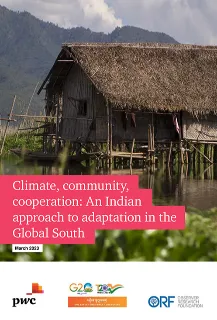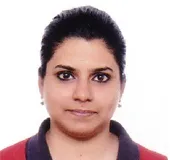The need to adapt to the now inevitable impacts of climate change is becoming increasingly urgent. However, there is still a long way to go in terms of strengthening resilience, reducing vulnerabilities and sensitivities, and unlocking the adaptive capacities of global interconnected systems. According to the IPCC, global average temperatures have risen drastically since pre-industrial levels.4 If not controlled immediately, achieving the 1.5 °C limit for global temperature rise will be extremely difficult. Climate change is no longer a debate for the future, but a lived reality for several millions of people across the world. We are in the midst of a climate emergency, and it is our moment to take action. Globally, the decade from 2012 to 2021 was the warmest on record.5 Over the previous four decades, average worldwide sea surface temperatures have risen by around 0.6 °C. Rainfall has become less frequent and the number of drought events has increased in the past few decades. In 2022, India experienced extreme weather events on 314 out of 365 days. Thunderstorms and lightning claimed the highest number of lives (1,285; 58% of total such deaths), followed by floods and heavy rains (835 deaths), snowfall (37 deaths), heat waves (30 deaths) and dust storms (22 deaths).6 The serious threats caused by these changes to human life, property and well-being are more pronounced for the developing world. Key takeaways from the study A sociocultural response framework As per CCPI 20231 published by Germanwatch, the New Climate Institute and Climate Action Network International based in Germany, India earned a high rating in the GHG Emissions and Energy Use categories and a medium rating for Climate Policy and Renewable Energy. Not only the government but also the private sector is taking steps to mitigate the changes.
Private sectors businesses, medium and small-scale industries and global supply chains are also now altering their priorities to align with climate mitigation efforts through net zero targets. PwC’s 26th Annual Global CEO Survey, which polled 4,410 CEOs in 105 countries, including 68 CEOs from India, found that around 24% of Indian CEOs (14% of global CEOs) felt that climate change poses a major threat to their top line and is driving the development and integration of corporate climate strategies. India’s top five business conglomerates are planning multi-billion dollar investments in hydrogen, renewable energy generation and innovative climate-friendly products to rank among the world’s top climate-neutral companies. With its financial strength and strategic thinking, the private sector can play a critical role in accelerating the urgent transformational changes for green growth.
In this context, this study intends to assess India’s present approaches to disaster and climate risk management, adaptation and resilience building, to record best practices and analyse how these approaches can be scaled up globally as well as domestically by driving more investments. The study was carried out across four states – Odisha, Maharashtra, Assam and Meghalaya – with the objective of tackling the major climatic disasters confronting India today and their impacts on vulnerable landscapes. The states chosen for the study are dealing with the main disasters that affect India, and they also have a long history of disaster management and adaptation initiatives. Odisha has a lengthy history of cyclones, and its zero-causality policy has attracted attention globally. Droughts are common in Maharashtra and its drought-proofing strategies have reduced the plight of farmers significantly. Assam and Meghalaya are seeing greater unpredictability in annual and seasonal rainfall, as well as frequent landslides. However, a rich legacy of community adaptation initiatives, nature-based approaches in economic revival and the use of multiple stakeholders, including military forces, are helping the states fight extreme weather events. The study highlights the lessons learnt in dealing with multiple disasters and provides a blueprint for scaling up these practices in similar geographies and socioeconomic contexts.
A sociocultural response framework
The state of Odisha has effectively kept mortality rates due to cyclones low, earning itself a global reputation in disaster management. The United Nations has lauded Odisha as a ‘global success story’ and a model for other states and cities. Since the severe cyclones in 1971 and 1999, Odisha has been pushing for ‘zero casualty’ or minimum deaths. OSDMA believes in capacity building of local communities as ‘first responders’ to extreme weather events and has constructed public infrastructure such as multipurpose cyclone shelters which can be used by the community even beyond cyclone protection. Odisha has also made positive strides in EWS, with DMR centres installed in each of the six coastal blocks. Vulnerable communities are taught search and rescue, first aid, and community shelter management as part of the Aapada Mitra Scheme. This training has aided in the development of self-sufficient communities. These trained ‘disaster warriors’ have contributed to making Odisha a champion in cyclone and tsunami management. On similar lines, in Assam, communities come together to rebuild damaged houses under a traditional system called hariya. Built on the traditional philosophies of mutual trust, cooperation and collaboration, indigenous practices observed in both Odisha and the Northeast help in achieving community-level adaptation and resilience. Both Odisha and Assam, with their extensive expertise in disaster management believe in CBDP, which has led to the development of decentralised risk mapping, localised action plans and local institutional strengthening. With climate change increasing the frequency of natural hazards in the nation, these approaches provide an optimistically detailed framework where environment protection, sustainable development, economic growth and social equity are woven together in a single matrix to strengthen the resilience of our common future.
Technology for climate adaptation and resilience
Maharashtra has been afflicted by droughts for decades. Maharashtra’s water train to supply drinking water in droughtaffected villages attracted considerable media attention in 2016. Subsequently, the state launched Jalyukt Shivar Abhiyan (a water conservation scheme) to make the state drought free by 2019. The state’s efforts to connect the private sector and farmers in order to enable direct procurement and provide farmers with access to the latest technology are key highlights which could be scaled up going forward. Several drought-afflicted districts of Maharashtra that saw a high number of farmer suicides are employing climate-proof farming. In many places, greenhouse farming is being introduced to cultivate high-yield varieties of crops.
Farmers are also involved in artificial cross-breeding of desired crop types, which is largely employed for the manufacturing of hybrid seeds. The region’s groundwater level has risen because of the watershed programme, and soil erosion has been prevented through the construction of artificial barriers such as check dams, which also assist in keeping water stagnant during floods. Farmers in this region have altered their cropping pattern by transitioning to less waterintensive crops. They are also gradually shifting to organic farming to boost the carbon content of the soil. As part of the programme, farmers are taught how to make natural fertilisers. The private sector, which supplies the necessary crop types and obtains the harvested seeds, has been involved in these efforts. This has limited community migration in the region and instead made these farmers employers. The Maharashtra example demonstrates how technology can address society’s most difficult challenges.
India’s technological advancements have been quite commendable, and the country can emerge as a pioneer in enhancing forecasting and EWS. The IMD intends to create 660 DAMUs by 2025, increasing coverage from 3,100 blocks in 2023 to 7,000 blocks in 2025. The Doppler Weather Radar Network is expected to cover all of India by 2025. This will aid in more precise forecasting of extreme weather occurrences. The Maharashtra government is attempting to map land parcels using satellite imagery for monitoring degraded farms and identifying loss and damage in the event of droughts and floods. The adoption of artificial intelligence (AI) to assess and analyse loss and damage will help in compensating farmers. Insurance firms can use these technologies to design climate risk insurance packages.
Going green
Assam has allocated 3% of the annual budget of all line departments of the state’s R&DM Department for disaster reduction. Climate budgeting, which was first introduced in 2012, has lately caught the attention of governments for state budget planning and revision. The Assam government is also using green budget tagging in many departments to address climate change challenges in line with its SDGs and development plans. This idea could be scaled up going forward. It is crucial to highlight that green budget tagging is only one part of green budgeting, which also includes a solid strategic framework and a supportive enabling environment. The indigenous housing methods of Odisha and Assam that are cyclone and flood resilient can be scaled up in other similar geographies. However, in our efforts to develop sustainable infrastructure, we must also employ sustainably sourced nature-based building materials.
Additionally, zero-budget natural farming should be given impetus by unlocking increased flow of investments in scientific agricultural research, climate-smart agricultural practices and agricultural extension. This will help in eliminating the negative impacts of climate change on food production as well as protect the livelihood of vulnerable communities.
Women first
The issues that various segments of vulnerable populations face are not the same. Disasters have a disproportionateimpact on the lives of women. Therefore, district and village-level plans should include the implications on various sections of vulnerable groups. As men relocate for jobs, women are often the first responders in rural communities. During storms, many women volunteers are deployed for search, rescue and first aid. The revenue generated by the community-managed shelters might be utilised to compensate community volunteers and keep them involved in disaster relief activities. Many women with children in Maharashtra have been widowed because of the high rate of farmer suicides. As a result, they have to work hard to make ends meet. Gender inclusion should be considered while choosing beneficiaries for farmer relief and assistance grants. It is important to frame solutions that bolster inclusivity and women’s empowerment.
India’s NDRF Warriors
The NDRF is now the world’s greatest rapid response force for disaster response.7 The BSF, CISF, CRPF, ITBP, SSB and Assam Rifles comprise over 15 battalions of the NDRF. Each battalion has a total strength of 1,149 soldiers. The IAF and NDRF activities in Assam and Meghalaya during the 2022 floods might be used as a model for flood relief operations in similar landscapes with difficult hysical accessibility in emergencies. As part of the state’s humanitarian aid and disaster relief (HADR) operation, the IAF flew 74 sorties, rescued 253 people caught in floods in Assam and Meghalaya, and dropped over 200 tonnes of relief goods. Along with the Indian Army, IAF and a medical team, 101 NDRF personnel are also assisting relief efforts following the earthquake in Turkey, thus transforming India into a ‘provider of assistance in international disasters’. India is also a donor, having recently contributed significant international disaster relief and foreign development aid to other nations, notably its neighbours like Bangladesh, Nepal, Myanmar and Sri Lanka. India has held DM exercises, which allow the NDRF to showcase disaster response tactics to their peers in other countries. When Nepal was devastated by a 7.8 magnitude earthquake in 2015, the NDRF stepped in.
The study elaborates on many good practices adopted by the four states and uses them as an integrated approach in India’s battle against climate change and increasing disaster risks. These approaches could be replicated not just across the country but also in other similar geographies, notably the SIDS and LDCs.
The adaptive nature of India’s democratic system provides tremendous scope to leverage cross-state and Centre-state exchange of institutional knowledge and technical capacities which can come handy in managing devastating natural hazards. The Inter-State and Zonal Councils introduced by the nation to support Centrestate and inter-state coordination and cooperation in India are excellent forums to bolster the exchange of institutional knowledge and capacities, continuous capacity building of states (through tailored need-based training, workshops, regional CoEs, etc.) as well as raising of funds for emergency response and relief operations. Specific resources, data and institutional knowledge of Regional Zonal Councils can be leveraged to conduct annual exercises and mock drills on disaster management and for long-term awareness dissemination activities of diverse stakeholders in different geographic contexts. In addition, a repository of location-specific best practices in DRR and climate risk mapping can be made available to the public as well as private agencies for cross-learning and scaling up in similar geographies in the larger Indo-Pacific region to foster international collaboration.
India has pioneered several ground-breaking initiatives – for example, the use of satellite remote sensing and geospatial technology for better climate information and decision support, the first domestic carbon market and investments in disaster-resilient infrastructure. In terms of creating financial resilience, the RBI, as a recent member of the NGFS, is actively looking at de-risking the Indian financial sector through robust identification, monitoring and management of climate risks.8 All of these measures demonstrate India’s ability to increase resilience through the loss and damage financing agreed upon during the COP27 discussions. To fully realise the value of this funding, the country must prioritise better quantifying the costs and benefits of resilience, improved risk information and cross-decisional coordination. G20 provides a distinctive opportunity for India to spearhead a unified model of resilience adaptation building among developing nations. The G20 has constituted a separate working group on DRR for the first time to encourage dialogue between developed and developing nations on effective response, preparedness and resilience building to extreme climatic events. Being at the helm of affairs, India’s key priority at this international platform would be to highlight the financing gap in fast-tracking DRR and CCA initiatives in a unified framework that looks at participatory approaches, increased women and youth participation, strengthened international collaboration, improved climate predictions and enhanced climate governance.
Assuming the G20 Presidency, India could position itself as a champion of climate action for the developing and emerging world. Finance delivery in accordance with earlier promises, increased private sector collaboration, access to a worldwide ESG finance pool, and the contribution of MDB must all be driven during this time and beyond.
Read the full report here.
The views expressed above belong to the author(s). ORF research and analyses now available on Telegram! Click here to access our curated content — blogs, longforms and interviews.

 PDF Download
PDF Download



 PREV
PREV






